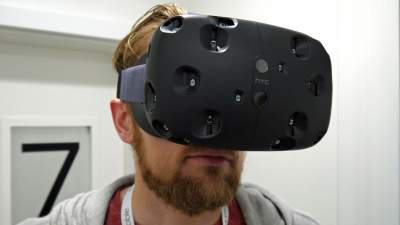 Today, even the most expensive headset Vive, we can observe the phenomenon of “grainy images”.
Today, even the most expensive headset Vive, we can observe the phenomenon of “grainy images”.
I think that the main problem of modern VR headsets is the presence of a wired connection to the video source? No. This is not so. One of the main disadvantages of the VR of our days is low resolution displays, which in the eyes of the user is a visual component. Today, even the most expensive headset Vive, we can observe the phenomenon of “grainy images”. But the engineers of the legendary Japanese company Sharp has figured out how to deal with this problem.
By far the most advanced virtual reality headset like the HTC Vive and the Oculus Rift can boast a resolution of 2160 x 1200 pixels. And it turns out exactly 1080 to 1200 pixels per eye. Is it good? Trying all three leading headsets, including HTC Vive, Oculus Rift (final version) and the PlayStation VR, I be honest: not really. In each of the set pixels in the matrix built-in screen clearly visible. Only here Sony went to some the trick and used in your headset is a special submatrices, thanks to which were able to use a smaller resolution (1920 x 1080 pixels and 960 x 1080 pixels per eye) while similar to the competitors result.
However, how would the market leaders tried, but their headsets cannot boast the same resolution that is used to seeing our eyes due to PC monitors. Largely to blame the lens, which greatly increase the screens built into VR headsets. When you increase the pixels begin downright conspicuous. Although after just a couple of minutes of resolution are starting to forget due to other components of virtual reality: the sound, the environment, interactivity, lack of delays between movements and display them in the game and so on.
Sharp has already introduced us to a new prototype of its displays of arbitrary shape that can be round, square, oval, triangular, and generally the kind of man you want. But in the latest version of this prototype Sharp has managed to achieve impressive resolution matrix. For example, a round display with a diameter of just 2 inches (about 5 centimeters) boasts a resolution of 1920 by 1920 pixels. Impressive, isn’t it? And just imagine now that with this permission will be able to make manufacturers of VR headsets.
The pixel density on the displays Sharp is around 1000 dpi. For comparison, the pixel density of the flagships of the eminent manufacturers of smartphones today is from 300 to 500 dpi. Yes, there were screens with a density of 2000 dpi, but they are sharpened not under the VR, but a completely different needs, so use them in sets would be difficult. It is difficult to say when exactly such a matrix will go on sale, but one thing is already clear: the VR headset of the future will be able to produce even more vivid impression than the already existing devices.






